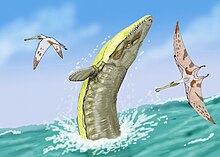噬蜥鳄属
噬蜥鱷屬(學名︰Dakosaurus),又譯達克龍或達寇龍。是中喙鱷下的一個屬,體型大,牙齒有鋸齒,側向扁平。噬蜥鱷是肉食性動物,大部份時間都生活於海洋中。從牠們那適應海中生活的特徵,可見牠們很可能是在海中交配。不過由於仍未有噬蜥鱷的蛋或巢被發現,究竟牠們是否如海豚及魚龍類般在海中出生,或是像龜在岸上出生,仍是未知。
| 噬蜥鳄属 化石时期:
| |
|---|---|

| |
| 巨噬蜥鱷自海面躍起,企圖獵食兩隻翼龍類 | |
| 科学分类 | |
| 界: | 动物界 Animalia |
| 门: | 脊索动物门 Chordata |
| 纲: | 爬行綱 Reptilia |
| 科: | †中喙鳄科 Metriorhynchidae |
| 亚科: | †地蜥鳄亚科 Geosaurinae |
| 族: | †地蜥鳄族 Geosaurini |
| 属: | †噬蜥鳄属 Dakosaurus von Quenstedt, 1856[1] |
| 模式種 | |
| 巨噬蜥鱷 Dakosaurus maximus (Plieninger, 1846)
| |
| 種 | |
| 異名 | |
| |
噬蜥鱷命名于1956年,由Friedrich August von Quenstedt根據數顆Th. Plieninger挖出的牙齒建立,當時為地蜥鱷。
詞源學 编辑
噬蜥鱷的屬名Dakosaurus來自希臘語 dakos,意為“噬咬”與sauros 意為“蜥蜴”,即“噬咬蜥蜴”,因為其雙顎長有鋒利的牙齒。[6][7]
發現與物種 编辑
在19世紀,噬蜥鱷的最早化石發現於德國,這些分散的牙齒曾被誤認為屬於獸腳亞目的巨齒龍[8]。在1856年,德國古生物學家von Quenstedt將Plieninger命名的巨地蜥鱷(Geosaurus maximus)牙齒化石,命名為噬蜥鱷(Dakosaurus)[9]。在當時,von Quenstedt認為噬蜥鱷是種恐龍[10]。
噬蜥鱷的化石已在英格蘭、法國、瑞士、德國[6]、波蘭[11]、俄羅斯[12]阿根廷、[3]、以及墨西哥等地發現[13]。另外在歐洲各地也發現噬蜥鱷的牙齒,年代屬於牛津階到凡藍今階[14][15]。
有效種 编辑
在噬蜥鱷屬中的物種包括:
- 巨噬蜥鱷(D. maximus):模式種,化石從西歐(英格蘭、法國、瑞士及德國)發現,生活於晚侏羅紀(晚啟莫里階至早提通階)[6][7]。
- 安第斯噬蜥鱷(D. andiniensis):生活於晚侏羅紀(晚提通階)至上白堊紀(早貝里亞階)。化石於1987年發現於阿根廷內烏肯省,但在1996年才建立名稱[3]。兩個近年發現的頭骨,口鼻部短而高,顯示安第斯噬蜥鱷在中喙鱷科(最適應海洋生活的鱷魚)中相當獨特;也使安第斯噬蜥鱷有「哥吉拉」的暱稱[16]。
- 尼西亞噬蜥鱷(D. nicaeensis):最初在1913年被分類為巨齒龍科恐龍。在1982年,被歸類為地蜥鱷科的安吉奧拉鱷屬Aggiosaurus,並是噬蜥鱷的近親[17]。模式標本的保存狀態差,因此被認為是疑名。在2009年的地龍重新研究,研究了相關物種的有效性、互相關係。在這份研究中,研究人員認為Aggiosaurus是達克龍的次異名[4]。
未命名種 编辑
在墨西哥的一個地層,發現了噬蜥鱷的不完整頭骨,年代為啟莫里階[13][18]。
分類 编辑
Dacosaurus是拼法錯誤[5]。根據2007年的親緣分支分類法研究,噬蜥鱷屬不是個單系群[19],巨噬蜥鱷與安第斯噬蜥鱷似乎另外形成一個單系群[16][19][20]。
| |||||||||||||||||||
已下演化樹則來自於2011年的地蜥鱷科體型研究[22]:
| |||||||||||||||||||
古生物學 编辑
體型 编辑
所有已知的噬蜥鱷物種都約為4到5米長,噬蜥鱷算是大型生物。牠的身體呈流線形,提供了強大的水動力。配合牠那有鰭的尾巴,使牠游泳比現今鱷魚更有效率[23]。
鹽腺 编辑
在墨西哥發現的不完整頭骨,其頭骨內有疑似鹽腺的腔室;地蜥鱷[24]與中喙鱷也有相同的鹽腺[25]。但沒有確切證據顯示這些腔室內含鹽腺[13]。
生態位 编辑
德國巴伐利亞州的Mörnsheim組(屬於索倫霍芬石灰岩,年代為早提通階)發現了5種海鱷類化石,其中包含巨噬蜥鱷龍、其他3種地蜥鳄、狹蜥鱷的化石。科學家提出這些海鱷纇的生態位不同,依此得以互相共存。噬蜥鱷與巨型地龍的體型大,口鼻部短,有鋸齒狀牙齒,似乎是當地的頂級掠食動物。纖細地龍、G. suevicus與真蜥鱷科狹蜥鱷可能主要以魚類為食[26]。
德國南部的Nusplingen石灰岩層,年代較索倫霍芬石灰岩晚,屬於啟莫里階晚期。當地發現了G. suevicus與巨噬蜥鱷(D. maximus)的化石。與索倫霍芬的狀況相同,噬蜥鱷是頂級掠食動物,而G. suevicus主要以魚類為。[27]。
食性 编辑
在海鱷類中,噬蜥鱷是唯一牙齒呈鋸齒狀、側向扁平,類似虎鯨;噬蜥鱷的體型也比其他地蜥鱷類大。[16]這些特徵顯示噬蜥鱷是種頂級掠食者[28]。
噬蜥鱷的上顳孔(Supratemporal fenestrae)大[7],上顳孔可提供內收肌的附著點[29],這意味達寇龍的咬合力大。噬蜥鱷的頭骨呈三角形,牙齒大、呈鋸齒狀、齒根深(類似上龍類),意味噬蜥鱷會採猛烈撕咬獵物身體的方式為食[30]。
參考 编辑
- ^ 1.0 1.1 Quenstedt FA. 1856. Sonst und Jetzt: Populäre Vortäge über Geologie. Tübingen: Laupp, 131.
- ^ Plieninger T. 1846. Prof. Dr. Th. Plieninger hielt nachstehenden vortrag über ein neues Sauriergenus und die Einreihung der Saurier mit flachen, schneidenden Zähnen in eine Familie. Pp. 148-154 in: Zweite Generalversammlung am 1. Mai 1846 zu Tübingen. Württembergische naturwissenschaftliche Jahreshefte 2: 129-183.
- ^ 3.0 3.1 3.2 Vignaud P, Gasparini ZB. 1996. New Dakosaurus (Crocodylomorpha, Thalattosuchia) from the Upper Jurassic of Argentina. Comptes Rendus de l'Académie des Sciences, Paris, 2 322: 245-250.
- ^ 4.0 4.1 Young, Mark T., and Marco Brandalise de Andrade, 2009. "What is Geosaurus? Redescription of Geosaurus giganteus (Thalattosuchia: Metriorhynchidae) from the Upper Jurassic of Bayern, Germany." Zoological Journal of the Linnean Society, 157: 551-585.
- ^ 5.0 5.1 Sauvage HE. 1873. Notes sur les reptiles, fossiles. Bulletin de la Société Géologiques de France, série 3: 365-384.
- ^ 6.0 6.1 6.2 Steel R. 1973. Crocodylia. Handbuch der Paläoherpetologie, Teil 16. Stuttgart: Gustav Fischer Verlag,116 pp.
- ^ 7.0 7.1 7.2 Fraas E. 1902. Die Meer-Krocodilier (Thalattosuchia) des oberen Jura unter specieller Berücksichtigung von Dacosaurus und Geosaurus. Paleontographica 49: 1-72.
- ^ Quenstedt FA. 1843. Das Flötzgebirge Württembergs: mit besonderer rücksicht auf den Jura. Tübingen: Laupp, 493.
- ^ Quenstedt FA. 1858. Der Jura. Tübingen: Laupp, 842 pp.(pgs. 785-786)
- ^ Quenstedt FA. 1859. Handbuch der Petrefaktenkunde. Tübingen: Laupp, 1239 pp.
- ^ Radwańska U, Radwański A. 2003. The Jurassic crinoid genus Cyclocrinus D’Orbigny, 1850: still an enigma. Acta Geologica Polonica 53 (2003),(4): 301-320.
- ^ Ochev VG. 1981. [Marine crocodiles in the Mesozoic of Povolzh'e] Priroda 1981: 103
- ^ 13.0 13.1 13.2 Buchy M-C, Stinnesbeck W, Frey E, Gonzalez AHG. 2007. First occurrence of the genus Dakosaurus (Crocodyliformes, Thalattosuchia) in the Late Jurassic of Mexico. Bulletin de la Societe Geologique de France 178 (5): 391-397.
- ^ BM(NH), Trustees of the. 1983. British Mesozoic Fossils, sixth edition. London: Butler & Tanner Ltd, 209 pp.
- ^ Benton MJ, Spencer PS. 1995. Fossil Reptiles of Great Britain. London: Chapman and Hall, 386 pp.
- ^ 16.0 16.1 16.2 Gasparini Z, Pol D, Spalletti LA. 2006. An unusual marine crocodyliform from the Jurassic-Cretaceous boundary of Patagonia. Science 311: 70-73.
- ^ Buffetaut E. 1982. Aggiosaurus nicaeensis Ambayrac, 1913, from the Upper Jurassic of south-eastern France: A marine crocodilian, not a dinosaur. Neues Jahrbuch für Geologie und Paläontologie, Monatshefte (8): 469-475.
- ^ Buchy M-C. 2008. New occurrence of the genus Dakosaurus (Reptilia, Thalattosuchia) in the Upper Jurassic of north-eastern Mexico with comments upon skull architecture of Dakosaurus and Geosaurus. Neues Jahrbuch für Geologie und Paläontologie, Abhandlungen 249 (1): 1-8.
- ^ 19.0 19.1 Young MT. 2007. The evolution and interrelationships of Metriorhynchidae (Crocodyliformes, Thalattosuchia). Journal of Vertebrate Paleontology 27 (3): 170A.
- ^ Wilkinson LE, Young MT, Benton MJ. 2008. A new metriorhynchid crocodilian (Mesoeucrocodylia: Thalattosuchia) from the Kimmeridgian (Upper Jurassic) of Wiltshire, UK. Palaeontology 51 (6): 1307-1333.
- ^ Andrea Cau; Federico Fanti. The oldest known metriorhynchid crocodylian from the Middle Jurassic of North-eastern Italy: Neptunidraco ammoniticus gen. et sp. nov. Gondwana Research. 2011, 19 (2): 550–565. doi:10.1016/j.gr.2010.07.007.
- ^ Mark T. Young, Mark A. Bell, Marco Brandalise de Andrade and Stephen L. Brusatte. Body size estimation and evolution in metriorhynchid crocodylomorphs: implications for species diversification and niche partitioning. Zoological Journal of the Linnean Society. 2011, 163 (4): 1199–1216 [2012-03-22]. doi:10.1111/j.1096-3642.2011.00734.x. (原始内容存档于2017-12-09).
- ^ Massare JA. 1988. Swimming capabilities of Mesozoic marine reptiles; implications for method of predation. Paleobiology 14 (2):187-205.
- ^ Fernández M, Gasparini Z. 2000. Salt glands in a Tithonian metriorhynchid crocodyliform and their physiological significance. Lethaia 33: 269-276.
- ^ Gandola R, Buffetaut E, Monaghan N, Dyke G. 2006. Salt glands in the fossil crocodile Metriorhynchus. Journal of Vertebrate Paleontology 26 (4): 1009-1010.
- ^ Andrade MB, Young MT. 2008. High diversity of thalattosuchian crocodylians and the niche partition in the Solnhofen Sea (页面存档备份,存于互联网档案馆). The 56th Symposium of Vertebrate Palaeontology and Comparative Anatomy
- ^ Dietl G, Dietl O, Schweigert G, Hugger R. 2000. Der Nusplinger Plattenkalk (Weißer Jura zeta) - Grabungskampagne 1999.
- ^ Massare JA. 1987. Tooth morphology and prey preference of Mesozoic marine reptiles. Journal of Vertebrate Paleontology 7: 121-137.
- ^ Holliday CM, Witmer LM. Archosaur adductor chamber evolution: integration of musculoskeletal and topological criteria in jaw muscle homology. Journal of Morphology 268 (6): 457-484.
- ^ Martill DM, Taylor MA, Duff KL, Riding JB, Brown PR. 1994. The trophic structure of the biota of the Peterborough Member, Oxford Clay Formation (Jurassic), UK. Journal of the Geological Society, London 151: 173-194.
外部連結 编辑
- Scientists reveal prehistoric terror(页面存档备份,存于互联网档案馆) - CNN
- Illustration(页面存档备份,存于互联网档案馆) - National Geographic